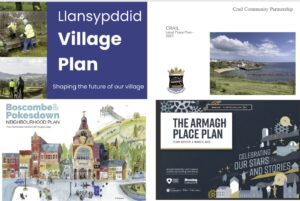
Content review: What Plans to consider?
Our content review is well underway now. The sample of plans selected are made up of under-represented places in the UK’s four constituent nations. The aim is to assess the coverage of issues in existing plans and identify and understand key issues and policies as developed by communities.
So far, the review process has involved two stages:
Stage 1: Sift
This is where the scoping and nominating areas formed the first stage or Local Authority ‘sift’. We adopted a slightly different approach for the four nations. This was a necessary and pragmatic approach given the scale of CLP activity across England, the smaller number of Local Authorities across Wales, NI and Scotland means we have had the capacity to assess all local authority areas in the stage one sift.
For England, in addition to the IMD data, we drew on the work by OCSI and Local Trust (2019) who identified 225 left behind neighbourhoods (wards) in England – although such categorisation is imperfect and a wider debate over contested framings of ‘left behind’ places (Natarajan and Cho, 2022; Pike et al., 2023) is recognised. We created a long list of Local Authorities that feature LBPs, as well as the top 20% of IMD areas to ensure that the review stayed in scope and was made manageable, this created a list of 98 Local Authority areas We additionally searched for any NDPs beyond that sift which overtly discussed social / spatial (in)justice questions (see WP1a/b).
Stage 2: Sample
The initial preparatory work gave an initial estimate that the number of Plans to be reviewed in total (stage 3) across the four nations with around 45 in England; 25 in Scotland; Wales around 15 and a similar number in Northern Ireland.
For stage 2, the intention was to identify neighbourhood planning activity within the most deprived Local Authority areas across England. For England, there were up to 49 eligible LPA areas who fitted the criteria of recorded disadvantage and who had been engaging in neighbourhood planning. All 321 neighbourhood areas participating in NP in those LPAs were identified and correlated with the IMD LSOA data. Those that featured an LSOA which was located in a 10% (decile) or 20% (quintile) most deprived areas, were identified and this led neatly to the 45 plans to review.
The sample across the other nations are:
- All Local Place Plans in Scotland (with a latter focus on the highest 20% of SIMD (2020)
- All Place Plans in Wales (with a latter focus on the top quintile according to WIND data)
- All 11 Local Authority areas in Northern Ireland (producing Community Plans), and particularly focusing on ‘Place Plans’, and a spot check sample of Neighbourhood Renewal Area (NRA) Plans.